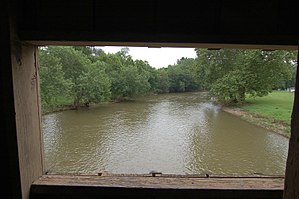Conestoga River
| Conestoga River | |
|---|---|

The Conestoga River as seen from the inside of Hunsecker's Mill Covered Bridge in Lancaster County
|
|
| Basin features | |
| Main source | Berks County, Pennsylvania |
| River mouth | Susquehanna River |
| Basin size | 491 square miles (1,270 km2) |
| Physical characteristics | |
| Length | 61.6 miles (99.1 km) |
| Discharge |
|
The Conestoga River, also referred to as Conestoga Creek, is a 61.6-mile-long (99.1 km)tributary of the Susquehanna River flowing through the center of Lancaster County, Pennsylvania.
Its headwaters rise mostly in southern Berks County (a small area rises in Chester County). The East Branch and West Branch of the Conestoga join to form the main river just north of Morgantown, and the stream flows from northeast to southwest for more than 60 miles (97 km), passing close to the center of Lancaster and ending at Safe Harbor along the Susquehanna River, approximately 16 miles (26 km) north of the Pennsylvania-Maryland state line.
The principal tributaries of the Conestoga River are Cocalico Creek, Mill Creek, and Little Conestoga Creek; they drain into the Conestoga River watershed in the order listed. The Conestoga River and its principal tributaries comprise approximately 114 stream miles, and they drain a watershed area of approximately 217 square miles (560 km2) if the main stream is alone considered, rising to 491 square miles (1,270 km2) when the Cocalico, Mill, and Little Conestoga Creek watersheds are also included.
The stream was named after a small tribe of the indigenous Iroquoian-speaking Susquehannock people, called the Susquehannocks by the English of Maryland and Virginia (an Algonquian name, Sasquesahanough, meaning "people of the muddy river") and the Conestoga by the English of Pennsylvania (from Kanastoge, meaning "place of the immersed pole", the name of their village in Pennsylvania). The village of Conestoga was reported to have two thousand inhabitants in the 17th century, and up to seven thousand people or more may have then lived in the watershed of the Conestoga River. By the early 18th century most of the Conestoga-Susquehannock were compelled to move to the Ohio area, where they gradually lost their distinctiveness as a nation. In 1763 the remaining Susquehannocks at Conestoga were attacked by the Paxton Boys, a group of anti-Indian vigilantes, who killed six of them at their village of Conestoga, and, two weeks later, despite official protection, killed fourteen of the remaining sixteen at the Lancaster workhouse. The two surviving Conestoga-Susquehannock worked as servants on a local farm until they died and were buried there.
...
Wikipedia
